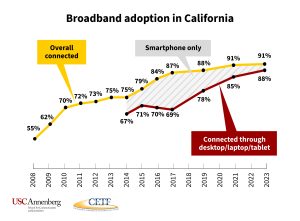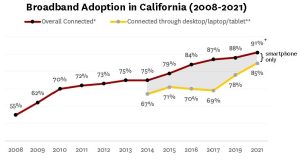Statewide Digital Equity Survey
2023 Survey
 The California 2023 Statewide Digital Equity Survey is a joint effort between the California Department of Technology (CDT) and the California Emerging Technology Fund (CETF), in partnership with the University of Southern California’s (USC) Annenberg School for Communication and Journalism. Dr. Hernan Galperin and Dr. François Bar were lead researchers, with assistance from Dr. Thai V. Le. The survey supported the preparation of California’s Digital Equity Plan and its application for federal funding from the Broadband Equity Access Deployment (BEAD) program, a key component of the 2021 Infrastructure Investment and Jobs Act (IIJA).
The California 2023 Statewide Digital Equity Survey is a joint effort between the California Department of Technology (CDT) and the California Emerging Technology Fund (CETF), in partnership with the University of Southern California’s (USC) Annenberg School for Communication and Journalism. Dr. Hernan Galperin and Dr. François Bar were lead researchers, with assistance from Dr. Thai V. Le. The survey supported the preparation of California’s Digital Equity Plan and its application for federal funding from the Broadband Equity Access Deployment (BEAD) program, a key component of the 2021 Infrastructure Investment and Jobs Act (IIJA).
Read:
- Final Report on the 2023 Statewide Digital Equity Survey
- December 18, 2023 Press Release: ‘Digital divide’ narrowing in California, but many low-income residents remain underconnected. (download the Slides from the January 2024 Press Briefing)
- California’s Digital Equity Plan (2024)
2021 Survey

The California 2021 Statewide Digital Equity Survey was a joint effort between the California Emerging Technology Fund (CETF) and the University of Southern California’s (USC) Annenberg School for Communication and Journalism. Dr. Hernan Galperin and Dr. François Bar were lead researchers, with assistance from Dr. Thai V. Le.
Read:
- Internet Adoption and the "Digital Divide" in California [March 2021]
- Supporting Sustainability and Expanding Learning and Health Services Through Broadband Investments [April 2021]
- Closing the Homework Gap In California: Promoting Broadband For K-12 Families Beyond the Pandemic [April 2021]